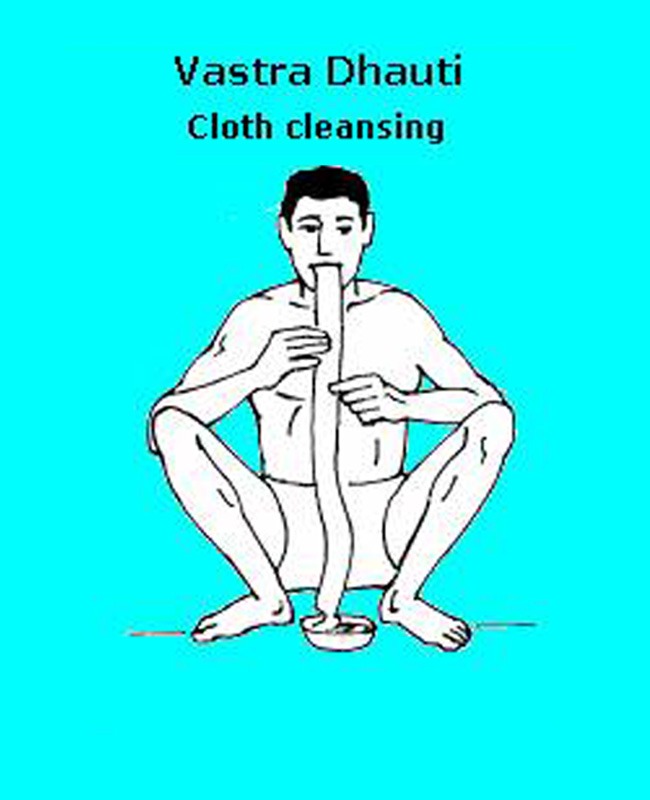Body cleansing procedure through Dhauti
Dhauti refers to the general techniques for cleansing different body parts and there different types of dhauti for different parts. These techniques are:
Danta Dhauti: it relates to cleaning the body parts above the neck region. It involves cleaning the teeth; Jihwa Dhauti for cleaning the toungue; Karna Dhauti for cleaning the ears; Kapalrandhra Dhauti for cleaning the head and scalp and Chaksua Dhauti for cleaning the eyes.
Vatsara Dhauti: it is the process of rejuvenating the stomach by swallowing or drinking air through the mouth. The air is circulated for some time and then expelled slowly by belching. This eliminates many stomach ailments.
Only some dhauti techniques that can be performed without expert supervision have been listed here.
Varisara dhauti or shankhaprakshalana
The word shankha means ‘conch’ and the word prakshalana means ‘to wash completely’. The technique is called shankhaprakshalana as it washes the conch-shaped intestines.
It is a systematic and gentle method of completely washing the entire alimentary canal from the mouth to the anus. The process is rather long and it is advisable to initially learn the practice under the guidance of a yoga teacher.
Preparation-
- On the day of performing shankhaprakshalana, no food, tea, coffee, etc. should be consumed prior to commencement of the technique.
- A clean bucket or similar container should be filled with lukewarm water.
- Salt must be added (2 teaspoons per liter) so that the water tastes salty.
- Wear light and comfortable clothes for you will be doing exercises.
- This technique should be performed amidst an atmosphere of happiness and relaxation.
- There should be no tension or trepidation. For this reason it is best done with a group.
Technique-
- Drink 2 glasses of salty water as quickly as possible.
- Perform the following 5 asanas 8 times each
(i)Tadasana (Exercise-61)
(ii)Tiryaka tadasana (Exercise-62)
(iii)Kati chakrasana (Exercise-60, variation 2).
(iv)Tiryaka bhujangasana (Exercise-70). v) Udarakarshan asana (Exercise-28). - There are a number of sphincters or valves in the alimentary canal between the stomach and the anus which open and close to allow the controller passage of food during the digestive process. The five asanas practised during shankhaprakshalana relax the muscles of these valves and allow the salty water to pass freely and quickly to the anus for discharge.
- After repeating all 5 asanas 8 times each, drink 2 more glasses of salty water and again perform the 5 asanas 8 times.
- Repeat this procedure once more.
- Now go to the toilet and try to evacuate the bowels.
- Do not strain under any circumstances, just relax and after a minute or so in the toilet, come out.
- Drink 2 more glasses and perform the 5 asanas times again.
- Then go to the toilet, but do not force.
- Continue this process, eventually a motion will occur.
- Do not compare yourself with others. Do not worry if you take a longer time to evacuate or have to drink more water than others.
- At first solid stool will be evacuated and then probably water and stool mixed.
- Carry on drinking 2 glasses of water, doing the asanas and going to the toilet.
- Eventually only clean water will be evacuated.
- 0n an average between 16 and 25 glasses of salty water must be consumed before clean
- water is evacuated. Some will need less and some more.
At this stage shankhaprakshalana is completed.
Additional practices-
Kunjal Kriya- Additional water in the stomach is vomited out through induced vomiting.
Jala neti- The process of cleansing the nostrils should be done immediately after completing shankhaprakshalana.
Kunjal cleans the region from the stomach to the mouth and also removes any remaining salty water from the stomach. jala neti cleans the nasal passages.
Rest-
After completing shankhaprakshalana rest is essential.
Lie down or sit quietly for 45 minutes.
Do not sleep. During this period the whole digestive system is having the best rest possible.
Special food-
45 minutes after shankhaprakshalana a special preparation of rice, pulse (mung dal) or lentils, cooked with ghee (clarified butter) must be taken. This preparation is necessary to activate and lubricate the digestive tract in a gentle manner. Remember, shankhaprakshalana has not only removed all the waste matter from the alimentary canal, but also all the natural and necessary protective layers from the walls of the digestive tract, leaving them bare. The ghee is essential to provide a temporary protective coating until the body provides a new layer
It is not normal for to intestines to be completely empty, especially for long periods of time without any protective coating. Therefore, while the ghee provides the wall coating, the rice supplies an easily digestible “packing” material and the lentils or dal supply a high protein food. It supplements the carbohydrate from the rice and the fat from the ghee for an all-round nutritious meal.
Food restrictions
- For at least one week or longer, all chemically processed, acidic, rich and non-vegetarian foods should be strictly avoided.
- Milk, buttermilk and acidic fruits such as lemons, grapefruit, oranges, etc. are also restricted.
- Alcohol, cigarettes, tea, coffee, betel nut preparations such as paan should not be taken for at least one week.
- The diet should be as pure, simple and neutral (not too acidic) as possible. Remember the whole digestive system has been cleaned. A sudden induction of toxic and poisonous foods might produce bad reactions such as fever, indigestion, constipation and so on.
Frequency-
Every six months, or more often under special circumstances.
General advice–
The rules are extensive but each one has a valid reason for being carried out. Disregarding any rule can cause problems. Though we have given the technique here, it should only be done under expert guidance.
VARIATION-Laghoo shankhaprakshalana (short stomach wash)
Early in the morning, before eating or drinking anything, prepare water in the same way as for shankhaprakshalana.
Drink two glasses, practice the same five asanas, eight times each as already described.
Then drink two more glasses of salty water and repeat the asanas.
Drink two more glasses of water and again repeat the asanas.
Now go to the toilet.
Usually after the practice there is a very clear bowel movement plus a large quantity of urine.
Time and sequence
- This practice should be done early in the morning or on an empty stomach.
- For therapeutic purposes it may be practiced daily without harm.
- Otherwise once or twice a week is sufficient.
This practice is for people who are unable to practise the full course of shankhaprakshalana due to lack of guidance or for any other reasons.
Precautions-
Wait at least half an hour after completing laghoo shankhaprakshalana before eating anything.
For this practice there are no dietary restrictions.
Limitations-
Persons suffering from stomach or duodenal ulcers should attempt this only under expert supervision.
High blood pressure patients may practice it, but they should use plain water without salt.
Benefits
Many ailments occur because of accumulated toxic matter in the intestines which tends to make the bloodstream impure. This has repercussions on the whole body.
- A complete cleaning of the digestive tract purifies the blood and manifests in a noticeable improvement in the health of the entire body.
- Most diseases that are associated with the digestive system are relieved. These include diabetes, hyperacidity, chronic dysentery, constipation and conditions arising from toxic blood.
It gives a feeling of lightness, a clear mind, cheerfulness and a general exhilaration with life.
- It is essential for spiritual aspirants to perform this practice prior to the commencement of any higher sadhana.
- This is a highly recommended practice for sufferers of chronic constipation, gas, acidity, indigestion and other digestive upsets.
- It is also good for the kidneys and urinary system as it helps to prevent urinary infections and the formation of kidney stones.
GO BACK



Facebook Comments